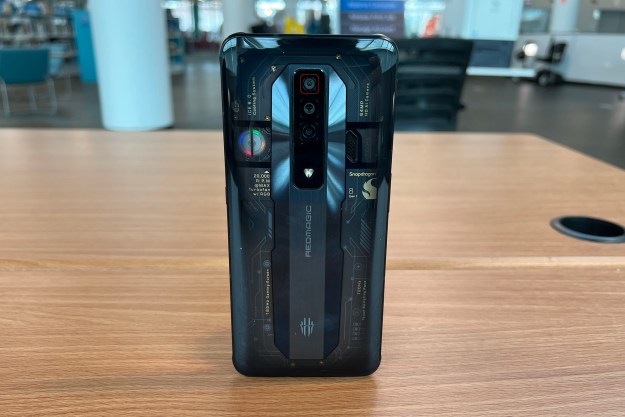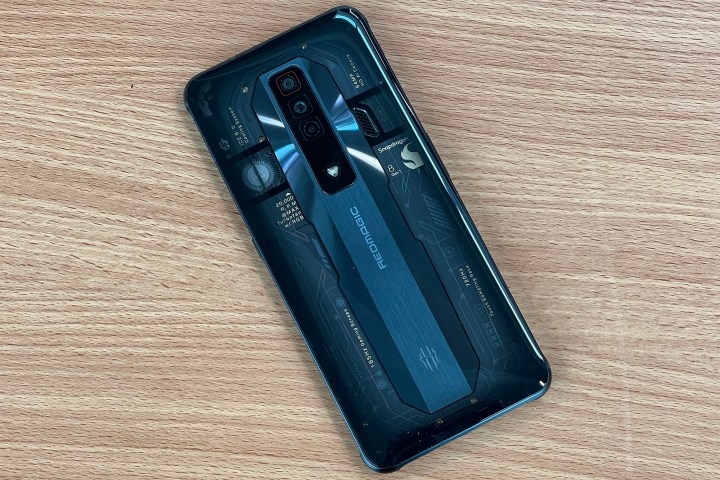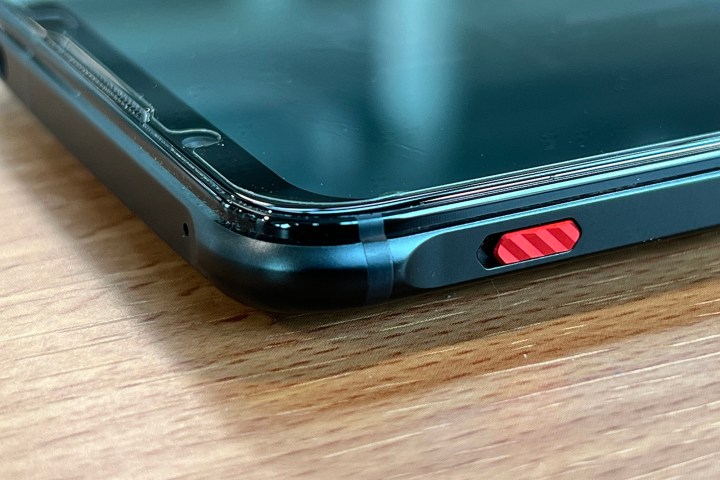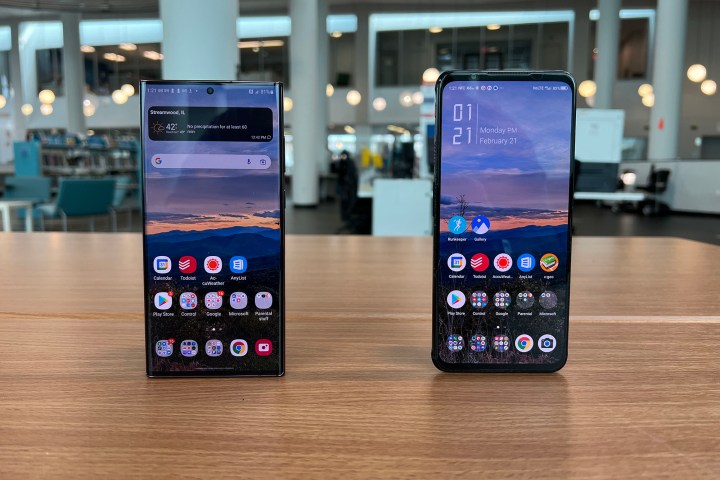
“The Nubia RedMagic 7 is an excellent phone for gamers, but casual users might want to steer clear.”
- Powerful
- Awesome design
- RGB cooling fan
- Headphone jack
- True gaming phone
- No IP Rating
- Camera is not great
- No 5G with T-Mobile
If you would have told me at the beginning of this year that the first Snapdragon 8 Gen 1-powered smartphone with a 6.8-inch screen would not be the Galaxy S22 Ultra, I wouldn’t have believed it. But sure enough, here we are. The Nubia RedMagic 7 took that distinction and is the kind of phone gamers should dream about because there’s so much for them to love here.
That isn’t to say that the Nubia RedMagic 7 is for everyone. There are some hard limitations that I’ll outline, but I wanted to approach this from the mindset of a gamer first, and everyone else second. So with that in mind, I’ve been using the phone as my daily driver for about two weeks on T-Mobile’s network. Here’s what I’ve found.
Design and hardware

Any review of the Nubia RedMagic 7 has to start with the hardware. While some manufacturers have chosen a very conservative approach to their hardware design, Nubia (and other gaming phones) has flipped the buffet table and gone its own way. This phone just smacks you in the face with the frying pan of design and dares you to question it.
Put frankly, there’s nothing about this phone that is small or boring, except perhaps its shape. Sure, it’s a black rectangle, but flip it over to look at the back or the sides and you’ll realize there’s a story here. My review unit is the Supernova version, which has a partially clear backplate with a sort of cheat sheet of specifications printed on it. You can also see the 20,000 RPM fan, and one of three vents on the back of the phone. Unfortunately, you can also see the dust that the fan collects under the glass
There’s a lot going on around the sides of this phone.
Going around the side of the phone, you’ll find a headphone jack on the top. Continuing clockwise on the right side, there are two touch-sensitive shoulder triggers on the top and bottom, a second vent for the fan, and the power button. On the bottom, there’s a single down-firing speaker, SIM tray, and USB-C charging and data port. And on the left side, you get a third vent, volume rocker, and a red-accented switch, which we’ll talk about later. There’s a lot going on around the sides of this phone.
On the front, there’s the aforementioned 6.8-inch AMOLED display, which I will also talk about later and is covered in Gorilla Glass 5. Up above the display is a single 8-megapixel selfie camera and the earpiece, which doubles as a second speaker.
Inside is where the power starts to become evident. As I mentioned above, the phone runs on Qualcomm’s latest Snapdragon 8 Gen 1 processor. My review unit carries 256 GB of internal storage and 18GB of RAM. It also has a 4,500, dual power cell battery and ships with a 65-watt fast charger in the box.
Display

If you can drag your eyeballs away from the back and sides of the phone (and the box for that matter), you’ll find a gorgeous 6.8-inch AMOLED panel with a 165Hz refresh rate. It’s limited to FHD+ resolution (1080 x 2400) — if you want to call that a limitation. The display also has a multi-finger 720Hz touch sampling rate, making it slightly more responsive than the shoulder triggers, not that you’ll notice.
The display is quite bright. As I mentioned with the Samsung Galaxy S21 FE, I typically increase screen brightness to 100% while gaming so I can see enough detail to not get my head blown off. I didn’t find that necessary with this phone. The screen itself can get quite bright if needed, and is easily readable in bright sunlight.
Color reproduction is great, with good depth in the shadows. The display also has great viewing angles. But the hardware is only a small part of the story. There’s a lot more to explore here, and the majority of that comes while gaming, so let’s talk about the software.
Software

The Nubia RedMagic 7 runs RedMagic OS 5.0, which is a fairly typical OS that you’ll see in Asian markets. By default, there is no app drawer, though there can be if you want one. One annoyance I found relates to searching for apps. I’m a fairly organized person when it comes to apps and folders, but I occasionally simply could not find the app I was looking for. In those cases, I had to switch the layout so I could have an app drawer.
Speaking of folders, the RedMagic 7 has the delightful ability to easily add apps to folders by tapping a simple plus symbol at the bottom of a folder. Every operating system should have this, full stop. Grabbing and dragging 180-plus apps into folders is not an awesome experience.
An oddity I found in the software relates to the notification shade. Whenever I have more than one notification for a given app, like mail, for example, I get a message that says “X notifications hidden.” The only problem is, it took me two weeks to figure out that it only happened when I had multiple notifications. I searched for hours for a way to not hide notifications. It seemed to me, if notifications are hidden, there should be a way to make them not hidden. It turns out, that’s just what the UI says when you have more than one notification; otherwise, it just tells you what the notification is.
The messenger app, which the phone uses for SMS, also has a weird quirk to it. When I send a text message to a group thread, I see the message twice, once as a bubble that I sent, and then a second that’s in line with the rest of the thread. My other recipients don’t get a double message, but it’s just another UI quirk that doesn’t make a lot of sense.
Game time!

The red-accented switch I mentioned earlier switches the phone into gaming mode. There’s a fairly simple layout for your games on a carousel. Flip between them and launch them as you wish. Game mode has a number of customizable settings including screen refresh rate, switching the cooling fan off and on, and setting the shoulder trigger functions. Those shoulder triggers, by the way, have a 500Hz touch sampling rate, so they’re a little “slower” than the screen itself, but it’s not noticeable during gameplay.
You can set the shoulder triggers to aim anywhere on the screen by simply dragging a target over the desired control in the game. There are seven different configurations that can be saved for each game. I’m not nearly a prolific enough gamer to need more than one configuration per game, but they’re there if you need them.
There’s also a handy plugin library that can enhance your gaming experience. There’s a sight assist that puts a dot or sight reticle in the middle of your screen to help you aim, stopwatches for timing your gameplay, and a key position assist that allows you to place virtual triggers anywhere on the screen and a corresponding touch target over the control you want to activate.
You can access the game control panel by swiping in from the bezel in either of the upper corners of the screen. The control panel also includes screen recorders, performance monitors, and a wealth of other functions. It puts most other “game modes” you’ll find on other smartphones to shame. These were designed with gamers in mind.
Camera

One of the compromises on this phone concerns the camera. That’s really unfortunate because while I can live with the lack of 5G (more on that later) and the IP rating, cameras are still really important to me. Maybe they’re not important to gamers, but the camera setup here is incredibly disappointing. There are three lenses here. The main camera is a 64-megapixel shooter, with an 8MP ultrawide and a 2MP depth sensor.
During the day, the camera is at best what I like to call “social media good.” That is to say that the camera can take acceptable photos to be used on Facebook, Instagram, or any other website that will take JPEGs and compress the living hell out of them. If they’ll never have to be seen at full resolution, this camera will be great. That’s also assuming you’re taking photos in good lighting.
In daylight or well-lit rooms, the camera is adequate. There is a huge difference in sensor size between the ultrawide sensor and the main camera, and it shows. The ultrawide loses a lot of detail and leans much darker than the main camera. That’s not surprising, and it’s normal when dealing with this kind of camera setup. The main camera sensor tends to be your best bet when it comes to detail and color accuracy, and the RedMagic 7 is no exception.
The camera also allows you to take photos at 2X, 5X, and 10X zoom, but it’s probably best if you just don’t do that. While 2X is not terrible, it’s also not very good. And 5X and 10X very quickly degrade to modern art masterpieces. Speaking of which, the camera has a plethora of camera modes you can try, my favorite of which is “Art Camera,” which turns your photo into a sort of impressionist watercolor. Very funky.
At night, the only camera that will give you anything approaching usable is the main camera. Of the dozens of photos I took in lowlight situations, I would consider a handful to be acceptable. It’s really not good. The main problem is the focus, which struggles in lowlight conditions. You can take good photos at night, but they are very much the exception, not the rule.
Overall, the camera is one of the worst cameras I’ve used in a while on a flagship. It’s on par with a midrange phone, which is not good, since this phone costs north of $700. Maybe gamers don’t care about camera performance; I’m not a gamer, so I can’t judge what a gamer’s reaction will be. If that’s the case, then none of this matters. But it matters to me.
Network, performance, and battery

Let’s get the network part out of the way first. This phone does not connect to T-Mobile’s 5G network. At first I assumed that was simply because this is a phone that isn’t meant for the United States. Nubia is a China-based brand and that’s not unusual at all. But when I double-checked the reviewer’s guide and noticed that this phone will be available not only in North America, but specifically in the U.S., I reached out to the RedMagic team, which confirmed that the phone operates only on the T-Mobile band n41, not band 70.
Given the fact that this phone will launch in the U.S .unlocked and that T-Mobile tends to be a popular choice for people who wield unlocked phones, this seems like a weird oversight. One could also argue that there isn’t a huge difference between T-Mobile 4G and T-Mobile
- Geekbench Single core: 1173
- Geekbench Multi-core: 3661
- Geekbench: Compute – 6115
- GFX T-Rex test: 166 fps
In terms of performance, what can I say except that this phone flies? The Snapdragon 8 Gen 1 processor is a beast, the 18GB of
Pushing that powerhouse along is a 4,500mAh split battery. The dual-battery design has become popular of late, and I can’t say I blame manufacturers. You get all the power you need, but in two smaller packages that recharge insanely fast. In the case of the RedMagic, that’s 31 minutes from empty to full when using the 65W charger that ships in the box. Did you hear that Samsung and Apple?
Not only does that allow you to charge your phone fast, but I also used the charger to power up laptops, tablets, and battery packs. It’s quite useful. But I won’t use this review as a soapbox except to say that as charging technology improves, it’s not right for manufacturers to force consumers to use their older, less-advanced chargers. Nor is it right to force them to buy new ones that are more up-to-date.
Pricing and availability
The RedMagic 7 will be available all around the world, including much of Europe, North America and Central America, Asia, and the Middle East. The Obsidian version (12 GB
Our take

Overall, I love this goofy phone, but I think that’s more about its goofiness than its actual features. From a specification standpoint, the RedMagic 7 tops the charts in every category a gamer will care about. The single exception to that might be the FHD+ display. All the same, that’s totally forgivable.
I would love to use this phone as my daily driver if for no better reason than to whip it out at parties and show people the crazy design on the back, the RGB fan, and the gaming switch. They border on gimmicks, except that they’re useful, albeit only in a gaming context. Knowing how many phones this year will have all that, but with a conservative design, it’s hard to pledge my undying loyalty to this phone based solely on its design and gaming features.
There’s nothing wrong with the design. but I wonder if the other compromises (especially the camera) would start to grate after a while. If this can be a secondary device used for gaming, while you take photos with another device, then there’s no reason why this phone can’t be a great device that’s really priced right.
Is there a better alternative?
In terms of gaming phones, this is about the best you can buy right now. There are some other gaming phones out there, some of which will probably get an upgrade this year. But right now, the RedMagic 7 is the top of the mountain. It has all the power you need, plus a suite of features catered to gamers. Even the Galaxy S22 Ultra (AT&T model pictured above with the RedMagic 7) tops out at 12GB of
Will it last?
RedMagic offers a two-year warranty on all of its phones, which is more than you usually see from a phone manufacturer. The build is solid, but the screen is only protected by Gorilla Glass 5, which is not the latest glass available. The phone ships with a case in the box, which should help with durability.
Should I buy it?
If you are a gamer, yes. If you’re anyone else, no. While the gaming features on this phone are really great, ultimately, the phone is a one-trick pony. It’s a really great gaming phone, but it’s not very good at everything else phones are supposed to do.




























